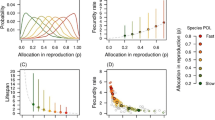Abstract
Mites have simple life styles and overlapping generations, thus analysis of their populations using stable theory (Lotka's equation) is particularly appropriate. While use of this demographic framework is widespread among mite researchers, the specific context in which it is applied is typically restricted to the conventional life table and associated parameters.
In this paper we extend the use of the basic principles of stable population theory in mite populations to include: (i) expectation of future life expectancy and reproduction; (ii) effect of developmental time on population growth rate; (iii) sensitivity analysis of a two-sex model; (iv) distribution of biomass and productivity in stable mite populations; (v) demographic theory of kinship as applied to mites; and (vi) mite mass-rearing. Implications of each are briefly discussed in the context of mite ecology and management.
Similar content being viewed by others
References
Carey, J.R., 1982. Demography of the twospotted spider mite,Tetranychus urticae Koch. Oecologia, 52: 289–295.
Carey, J.R., 1983. Practical application of the stable age distribution: analysis of a tetranychid mite (Acari: Tetranychidae) population outbreak. Environ. Entomol., 12: 10–18.
Carey, J.R., 1986. Interrelations and applications of mathematical demography to selected problems in fruit fly management. In: M. Mangel, J. Carey and R. Plant (Editors), Pest Control: Operations and Systems Analysis in Fruit Fly Management. Springer, Berlin, pp. 227–262.
Carey, J.R. and Bradley, J.W., 1982. Developmental rates, vital schedules, sex ratios and life tables ofTetranychus urticae, T. turkestani andT. pacificus (Acarina: Tetranychidae) on cotton. Acarologia, 23: 333–345.
Carey, J.R. and Vargas, R., 1985. Demographic analysis of insect mass rearing: case study of three tephritids. J. Econ. Entomol., 78: 523–527.
Caswell, H. and Hastings, A., 1980. Fecundity, developmental time, and population growth rate: an analytical solution. Theor. Pop. Biol. 17: 71–79.
Goodman, L.A., 1953. Population growth of the sexes. Biometrics, 9: 212–225.
Goodman, L.A., Keyfitz, N. and Pullum, T.W., 1974. Family formation and the frequency of various kinship relations. Theor. Pop. Biol., 5: 1–27.
Hamilton, A., Botsford, L.W. and Carey, J.R., 1986. Demographic analysis of sex ratio in the twospotted spider mite,Tetranychrus urticae. Entomol. Exp. Appl., 41: 147–151.
Helle, W. and Sabelis, M.W. (Editors), 1985. Spider Mites, Their Biology, Natural Enemies and Control. Vols. 1A & 1B. Elsevier, Amsterdam, 406 pp. & 458 pp.
Helle, W. and Overmeer, W.P.J., 1985. Rearing techniques. In: W. Helle and M.W. Sabelis (Editors), Spider Mites, Their Biology, Natural Enemies and Control. World Crop Pests, Vol. 1A. Elsevier, Amsterdam, pp. 331–335.
Keyfitz, N., 1985. Applied Mathematical Demography, Springer, New York, 441 pp.
Laing, J.E., 1968. Life history and life table ofPhytoseiulus persimilis Athias-Henriot. Acarologia, 10: 578–588.
Lewontin, R.C., 1965. Selection for colonizing ability. In: H.G. Baker and G.L. Stebbins (Editors), The Genetics of Colonizing Species. Academic Press, New York, pp. 77–91.
Lotka, A.J., 1922. The stability of the normal age distribution. Proc. Nat. Acad. Sci., 5: 339–345.
Overmeer, W.P.J., 1985. Rearing and Handling. In: W. Helle and M.W. Sabelis (Editors), Spider Mites, Their Biology, Natural Enemies and Control, Vol. 1B. Elsevier, Amsterdam, pp. 161–170.
Snell, T.W., 1978. Fecundity, developmental time, and population growth rate. Oecologia, 32: 119–125.
Thurling, D.J., 1980. Metabolic rate and life stage of mitesTetranychus cinnabarinus Boid. (Prostigmata) andPhytoseiulus persimilis A-H. Mesostigmata). Oecologia, 46: 391–396.
Wrench, D.L. and Young, S.S.Y., 1978. Effects of density and host quality on rate of development, survivorship, and sex ratio in the carmine spider mite. Environ. Entomol., 7: 499–502.
Yasuda, M., 1980. Changes in the distribution pattern, sex ratio and age-class structure during population growth of the citrus red mite,Panonychus citri (McGregor). Appl. Entomol. Zool., 15: 447–457.
Author information
Authors and Affiliations
Rights and permissions
About this article
Cite this article
Carey, J.R., Krainacker, D.A. Demographic analysis of mite populations: extensions of stable theory. Exp Appl Acarol 4, 191–210 (1988). https://doi.org/10.1007/BF01196186
Accepted:
Issue Date:
DOI: https://doi.org/10.1007/BF01196186




